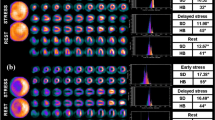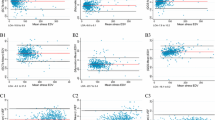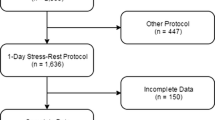Abstract
Myocardial perfusion scintigraphy with wall motion analysis is known to enhance accuracy in diagnosing ischemic heart disease. The purpose of this study is to determine the best method to evaluate regional wall motion in a gated planar perfusion study. Planar gated99mTc tetrofosmin (GTF) study in two projections was performed after rest-exercise sequence SPECT studies (n = 29). To evaluate wall motion, cine-mode display, wall thickening, and inverted tetrofosmin studies including ventricular inner border tracing, segmental wall shortening and functional images were used. The results were compared with gated blood-pool (GBP) study in the same projections. In the GTF study, functional image identified asynergy significantly better than cinematic display. The best correlation between GTF and GBP studies was observed with functional images of phase and amplitude, with complete visual agreement seen in 145 of 168 (86%) segments. With quantitative analysis by means of regions of interest (n = 280), a good correlation was observed between GTF and GBP regarding regional amplitude (r = 0.78), regional phase (r = 0.84), average left ventricular phase (r = 0.91) and standard deviation of phase values (r = 0.90). The value for the count-based “ejection fraction” derived from inverted GTF showed insufficient correlation to that of the GBP study (r = 0.69). Functional imaging with myocardial perfusion imaging is a simple and effective means to evaluate ventricular asynergy. Similar diagnostic criteria to gated blood-pool imaging and comparable diagnostic accuracy are advantages of this approach.
Similar content being viewed by others
References
Brown KA, Altland E, Rowen M. Prognostic value of normal technetium-99m-sestamibi cardiac imaging.J Nucl Med 35: 554–557, 1994.
Van Train K, Garcia EV, Maddahi J, Areeda J, Cooke CD, Kiat H, et al. Multicenter trial validation for quantitative analysis of same-day rest-stress technetium-99m-sestamibi myocardial tomograms.J Nucl Med 35: 609–618, 1994.
Udelson JE, Coleman PS, Metherall J, Pandian NG, Gomez AR, Griffith JL, et al. Predicting recovery of severe regional ventricular dysfunction. Comparison of resting scintigraphy with201Tl and99mTc-sestamibi.Circulation 89: 2552–2561, 1994.
Altehoefer C, von Dahl J, Biedermann M, Uebis R, Beilin I, Sheehan F, et al. Significance of defect severity in technetium-99m-MIBI SPECT at rest to assess myocardial viability: comparison with fluorine-18-FDG PET.J Nucl Med 35: 569–574, 1994.
Braat SH, Leclercq B, Itti R, Lahiri A, Sridhara B, Rigo P. Myocardial imaging with Tc-99m tetrofosmin: comparison of one-day and two-day protocols.J Nucl Med 35: 1581–1585, 1994.
Nakajima K, Taki J, Shuke N, Bunko H, Takata S, Hisada K. Myocardial perfusion imaging and dynamic analysis with technetiurn-99m tetrofosmin.J Nucl Med 34: 1478–1484, 1993.
Rigo P, Leclercq B, Itti R, Lahiri A, Braat S. Technetium-99m-tetrofosmin myocardial imaging: A comparison with thallium-201 and angiography.J Nucl Med 35: 587–593, 1994.
Tamaki N, Takahashi N, Kawamoto M, Torizuka T, Tadamura E, Yonekura Y, et al. Myocardial tomography using technetium-99m-tetrofosmin to evaluate coronary artery disease.J Nucl Med 35: 594–600, 1994.
Matsunari I, Fujino S, Taki J, Senma J, Aoyama T, Wakasugi T, et al. Myocardial viability assessment with technetium-99m-tetrofosmin and thallium-201 reinjection in coronary artery disease.J Nucl Med 36: 1961–1967, 1995.
Smart SC. The clinical utility of echocardiography in the assessment of myocardial viability.J Nucl Med 35 (Suppl I): 49S-58S, 1994.
Wackers F, Mattera J, Bowman L, Zaret B. Gated Tc-99m-isonitrile myocardial perfusion imaging: Disparity between endo-, epicardial wall motion.Circulation 76 (S4): 203–207, 1987.
Marcassa C, Marzullo P, Parodi O, Sambuceti G, L’Abbate A. A new method for noninvasive quantitation of segmental myocardial wall thickening using technetium-99m 2-methoxy-isobutyl-isonitrile scintigraphy—results in normal subjects.J Nucl Med 31: 173–177, 1990.
Tischler MD, Niggel JB, Battle RW, Fairbank JT, Brown KA. Validation of global and segmental left ventricular contractile function using gated planar technetium-99m sestamibi myocardial perfusion imaging.J Am Coll Cardiol 23: 141–145, 1994.
Jamar F, Topcuoglu R, Cauwe F, De Coster P, Roelants V, Beckers C, et al. Exercise gated planar myocardial perfusion imaging using technetium-99m sestamibi for the diagnosis of coronary artery disease: an alternative to exercise tomographic imaging.Eur J Nucl Med 22: 40–48, 1995.
Williams KA, Taillon LA. Gated technetium 99m-labeled sestamibi myocardial perfusion image inversion for quantitative scintigraphic assessment of left ventricular function.J Nucl Cardiol 2: 285–295, 1995.
Manting F, Manting MGM. Gated SPECT with technetium-99m-sestamibi for assessment of myocardial perfusion abnormalities.J Nucl Med 34: 601–608, 1993.
DePuey EG, Rozanski A. Using gated technetium-99m sestamibi SPECT to characterize fixed myocardial defects as infarct or artifact.J Nucl Med 36: 952–955, 1995.
DePuey EG, Nichols K, Dobrinsky C. Left ventricular ejection fraction assessed from gated technetium-99m-sestamibi SPECT.J Nucl Med 34: 1871–1876, 1993.
Williams KA, Taillon LA. Left ventricular function in patients with coronary artery disease assessed by gated tomographic myocardial perfusion images.J Am Coll Cardiol 27: 173–181, 1996.
Faber TL, Akers MS, Peshock RM, Corbett JR. Threedimensional motion and perfusion quantification in gated single-photon emission computed tomograms.J Nucl Med 32: 2311–2371, 1991.
Adams WE, Tarcowska A, Bitter F. Equilibrium (gated) radionuclide ventriculography.Cardiovasc Radiol 2: 161–173, 1979.
Links JM, Douglass KH, Wagnar HN Jr. Patterns of ventricular emptying by Fourier analysis of gated blood-pool studies.J Nucl Med 21: 978–982, 1980.
Wendt RE III, Murphy PH, Clark JW Jr, Burdine JA. Interpretation of multi-gated Fourier functional images.J Nucl Med 23: 715–724, 1982.
Walton S, Yiannikas J, Jarritt PH, Brown NJG, Swanton RH, Ell PJ. Phasic abnormalities of left ventricular emptying in coronary artery disease.Br Heart J 46: 245–253, 1981.
Turner DA, Shima MA, Ruggie N, Von Behren PL, Jrosky MJ, Ali A, et al. Coronary artery disease: detection by phase analysis rest/exercise radionuclide angiocardiograms.Radiology 148: 539–545, 1983.
Henze E, Tymiec A, Delagardelle C, Adam WE, Bitter F, Stauch M. Specification of regional wall motion abnormalities by phase analysis of radionuclide angiograms in coronary artery disease and non-coronary artery disease patients.J Nucl Med 27: 781–787, 1986.
Brateman L, Buckley K, Keim SG, Wargovich T, Williams CM. Left ventricular regional wall motion assessment by radionuclide ventriculography: A comparison of cine display with Fourier imaging.J Nucl Med 32: 777–782, 1991.
Becker LC. [Editorial] Radionuclide ventriculography: Should Fourier analysis replace the cine display.J Nucl Med 32: 782–784, 1991.
Fintel DJ, Links JM, Bricker JA, Frank TL, Parker M, Becker LC. Improved diagnostic performance of exercise thallium-201 single photon emission tomography over planar imaging in the diagnosis of coronary artery disease. A receiver operating characteristic analysis.J Am Coll Cardiol 13: 600–612, 1989.
Author information
Authors and Affiliations
Corresponding author
Rights and permissions
About this article
Cite this article
Nakajima, K., Taki, J., Matsuyama, T. et al. Functional imaging of gated Tc-99m tetrofosmin study as a simple method to quantify ventricular wall motion. Ann Nucl Med 11, 87–94 (1997). https://doi.org/10.1007/BF03164815
Received:
Accepted:
Issue Date:
DOI: https://doi.org/10.1007/BF03164815




